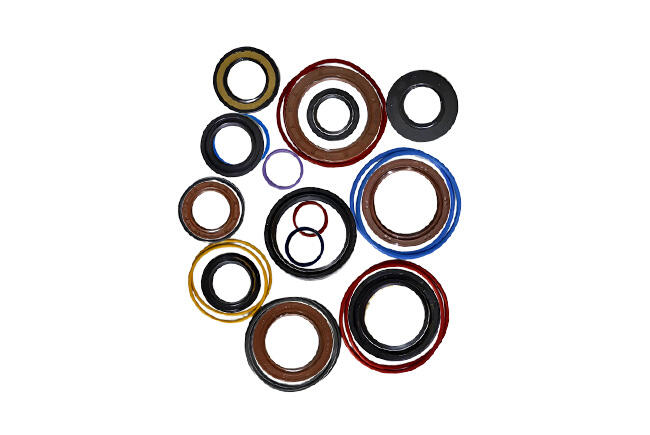In today’s intelligent manufacturing landscape, industrial robots have become the core of precision automation. From automotive assembly to semiconductor production, these machines work with extreme accuracy under continuous motion and high loads. Hidden within their joints, hydraulic drives, and pneumatic systems are small but vital components — sealing elements. The performance of a robot often depends not only on its sensors or control algorithms, but also on how well its seals handle heat, friction, and exposure to different media.
When it comes to selecting sealing components for industrial robots, the task goes far beyond choosing a standard oil seal or an O-ring. The operating conditions are complex: rotational speeds vary, pressure levels fluctuate, and environmental factors such as dust, chemical vapors, or high temperature come into play. Each motion axis of a robot demands a seal that can operate under combined dynamic and static conditions, all while maintaining tightness and minimizing wear.
Understanding Seal Types and Materials
In robotic systems, rotary shaft seals, O-rings and composite seals are among the most frequently used types. Each has distinct applications — for instance, rotary seals are essential in reducers and servo motor shafts, while O-rings are widely used in pneumatic or hydraulic cylinders. The choice of material directly affects durability and performance.
NBR (Nitrile Rubber): Known for excellent oil resistance, NBR is often used in hydraulic systems and low-temperature applications.
FKM (Fluorocarbon Rubber): Performs well under high temperature and chemical exposure, making it suitable for high-speed, high-load robot joints.
HNBR (Hydrogenated Nitrile Rubber): Offers balanced resistance to abrasion, heat, and oxidation, making it ideal for long-running operations.
PTFE (Polytetrafluoroethylene) and its composites are preferred in cleanroom robots or vacuum environments, where minimal friction and chemical stability are critical.
Selecting the right material involves understanding the robot’s operating medium — hydraulic oil, grease, air or special fluids — as well as the contact surface conditions. Pressure resistance, compression set, and flexibility are all factors that determine how long a seal will last before replacement.

Design Considerations Beyond the Material
Seal design plays a central role in achieving system reliability. The geometry of the lip, the spring tension, and the lubrication groove must be tuned to specific operating conditions. In multi-axis robots, even minor misalignment can cause uneven pressure distribution, resulting in premature leakage or seal failure. That’s why leading manufacturers conduct simulation testing and prototype validation before finalizing a design.
Another often-overlooked aspect is the interaction between the seal and the lubricant. In high-speed joints, the oil film must be stable enough to prevent frictional heating, while in pneumatic systems, seals must minimize air loss without sacrificing responsiveness.
What Distributors and Integrators Care About
For distributors, integrators and OEMs in the sector, sealing solutions are not just technical parts — they’re tied directly to delivery schedules and cost control. Downtime in an automation line can mean significant losses, so inventory availability and rapid supply become key considerations.
That’s why the NQKSF brand has gained strong recognition among industrial automation clients. The company maintains a comprehensive stock of standard sealing products — covering over ten thousand O-ring and oil seal specifications — ensuring fast shipment of standard parts to meet urgent project needs.
For more specialized applications, NQKSF provides fully customized sealing services, guiding customers through material selection, design development, and performance testing. This approach helps clients obtain seals precisely matched to their operating environments — whether it’s a cleanroom robot handling semiconductors, or a heavy-duty robotic arm operating in a foundry.
Technical Expertise and Corporate Strength
With over 30 years of sealing experience, NQKSF positions itself not only as a product supplier but as a technical partner. The company’s technical empowerment service helps clients enhance sealing performance, reduce maintenance frequency, and improve overall equipment reliability. Many manufacturers appreciate the ability to co-develop solutions, rather than merely purchase off-the-shelf products.
NQKSF is also recognized as a high-tech enterprise and a provincial-level specialized and innovative manufacturer. Its modern production base and testing facilities form a strong foundation for quality assurance. The company’s sealing products are supplied to more than 80 countries worldwide, serving industries such as robotics, hydraulics, wind power, and energy. As part of a leading industrial cluster, NQKSF continues to expand its footprint as one of the most trusted names in the sealing industry.
Toward a Smarter Future of Sealing
As robotics technology continues to evolve, the requirements placed on sealing components are becoming more sophisticated. Seals must now handle variable torque loads, aggressive lubricants, and extended maintenance intervals — all while maintaining compact dimensions and high repeatability.
For design engineers, selecting the right seal means balancing cost, performance, and service life. For procurement specialists and distributors, it’s about ensuring stable sourcing and technical support. And for end users, reliable seals mean longer uptime and consistent precision.
 Hot News
Hot News